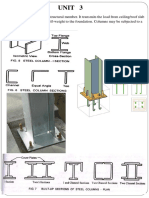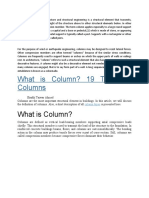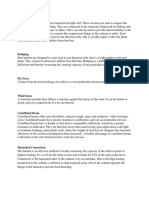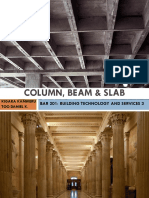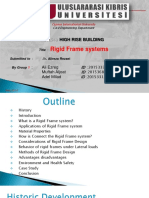0%(1)0% found this document useful (1 vote)
170 viewsSlender Columns
Slender Columns
Uploaded by
MervynThis document discusses slender columns in concrete construction. It defines a slender column as one where lateral deflections significantly reduce its axial load capacity by more than 5%. Slender columns experience increased moments and deflections from second-order P-Δ and P-δ effects. Most building columns are not slender, but exceptions can occur in industrial buildings or those with a tall first floor story.
Copyright:
© All Rights Reserved
Available Formats
Download as PDF, TXT or read online from Scribd
Slender Columns
Slender Columns
Uploaded by
Mervyn0%(1)0% found this document useful (1 vote)
170 views13 pagesThis document discusses slender columns in concrete construction. It defines a slender column as one where lateral deflections significantly reduce its axial load capacity by more than 5%. Slender columns experience increased moments and deflections from second-order P-Δ and P-δ effects. Most building columns are not slender, but exceptions can occur in industrial buildings or those with a tall first floor story.
Original Description:
A presentation on slender columns.
Original Title
Slender Columns PPT
Copyright
© © All Rights Reserved
Available Formats
PDF, TXT or read online from Scribd
Share this document
Did you find this document useful?
Is this content inappropriate?
This document discusses slender columns in concrete construction. It defines a slender column as one where lateral deflections significantly reduce its axial load capacity by more than 5%. Slender columns experience increased moments and deflections from second-order P-Δ and P-δ effects. Most building columns are not slender, but exceptions can occur in industrial buildings or those with a tall first floor story.
Copyright:
© All Rights Reserved
Available Formats
Download as PDF, TXT or read online from Scribd
Download as pdf or txt
0%(1)0% found this document useful (1 vote)
170 views13 pagesSlender Columns
Slender Columns
Uploaded by
MervynThis document discusses slender columns in concrete construction. It defines a slender column as one where lateral deflections significantly reduce its axial load capacity by more than 5%. Slender columns experience increased moments and deflections from second-order P-Δ and P-δ effects. Most building columns are not slender, but exceptions can occur in industrial buildings or those with a tall first floor story.
Copyright:
© All Rights Reserved
Available Formats
Download as PDF, TXT or read online from Scribd
Download as pdf or txt
You are on page 1of 13
Slender Columns
Columns
Cast-in-place concrete columns
typically carry both axial loads
and moments.
Interior columns have moment
due to the difference in the
moments on the adjacent spans
Exterior columns have larger
moments because they only have
a slab or beam framing into one
side.
Effect of Shape
Reinforcing Configurations
Slender
A slender column is defined as a column that has a
significant reduction in its axial-load capacity due to
moments resulting from lateral deflections of the
column.
In the derivation of the ACI Code, a significant
reduction was arbitrarily taken as anything greater
than about 5%
Basis of Slender
Lateral deflections of a slender column cause an increase in the column
moments,
These increased moments cause an increase in the deflections, which n turn
lead to an increase in the moments.
If the axial load is below the critical load, the process will converge to a
stable position. This is referred to as a second-order process
Two different types of second-order moments act on the columns in a
frame:
P- moments. These result from deflections, of the axis of the bent column
away from the chord joining the ends of the column
P- moments. These result from lateral deflections, of the beamcolumn joints
from their original undeflected locations
Most building columns fall in the short-column category. Exceptions
occur:
in industrial buildings and in buildings that have a high first-floor story for
architectural or functional reasons.
Some bridge piers and the decks of cable stayed bridges
Differences in moments
Pin-ended columns are rare in cast-in-place concrete construction, but
do occur in precast construction.
the columns supporting the back of a precast grandstand.
Braced and Unbraced
Most concrete building structures are braced (nonsway) frames
the bracing provided by considerably stiffer elements than the
columns themselves:
shear walls,
stairwells, or
elevator shafts
Unbraced frames are encountered:
near the tops of tall buildings, where elevator core may be discontinued
in industrial buildings where an open bay exists.
You might also like
- Inclined Columns Design - Loads and Bending Moment in Inclined ColumnDocument5 pagesInclined Columns Design - Loads and Bending Moment in Inclined ColumnJustin Musopole100% (2)
- Dimensions, Weights and Properties of Special and Standard Structural Steel Shapes Manufactured by Bethlehem Steel CompanyFrom EverandDimensions, Weights and Properties of Special and Standard Structural Steel Shapes Manufactured by Bethlehem Steel CompanyNo ratings yet
- Elearning - Vtu.ac - in 17 E-Notes 10CV52 Unit6-MCNDocument24 pagesElearning - Vtu.ac - in 17 E-Notes 10CV52 Unit6-MCNKunwarKhaliqeAhmad0% (1)
- Unit6 MCNDocument24 pagesUnit6 MCNNithesh ShamNo ratings yet
- RigidframesystemsDocument42 pagesRigidframesystemssujan pokhrelNo ratings yet
- 25 AsmitaS25 Portal FramesDocument16 pages25 AsmitaS25 Portal FramesAsmita SutarNo ratings yet
- Diff Shortening of Tall Steel Building Columns TaranathDocument8 pagesDiff Shortening of Tall Steel Building Columns TaranathgoggingsNo ratings yet
- Frame Structures Frame Structures: Hiba A. Al-Kareem Hiba A. Al-KareemDocument27 pagesFrame Structures Frame Structures: Hiba A. Al-Kareem Hiba A. Al-KareemMustafa AhmadNo ratings yet
- Unit - Iv: Limt State Design of ColumnsDocument26 pagesUnit - Iv: Limt State Design of ColumnsTesfa HunderaNo ratings yet
- Framed StructuresDocument12 pagesFramed Structures211Dena hassan mohamedNo ratings yet
- Unit 3 FinalDocument14 pagesUnit 3 FinalsandeepNo ratings yet
- Memik Palev Simelinisemik MofezifeviDocument2 pagesMemik Palev Simelinisemik Mofezifevihanna alemhuNo ratings yet
- Types of ColumnDocument9 pagesTypes of ColumnMA. LOU ANGELICA ANGCAYANo ratings yet
- Steel Trusses PDFDocument73 pagesSteel Trusses PDFmayuresh barbarwar100% (1)
- R.C. Columns محاضرةDocument43 pagesR.C. Columns محاضرةMustafa TalibNo ratings yet
- Chapter Four ColumnsDocument27 pagesChapter Four ColumnsTemam MohammedNo ratings yet
- Adamson UniversityDocument20 pagesAdamson UniversityKim Yun Shik PegoriaNo ratings yet
- Design of Industrial BuildingsDocument29 pagesDesign of Industrial Buildingsbrownpepper30100% (2)
- Lecture 01Document10 pagesLecture 01sisacs2002No ratings yet
- Chapter 1 - Fundamentals of Steel DesignDocument31 pagesChapter 1 - Fundamentals of Steel DesignMica Ella Mercado100% (2)
- Gier, Estiven M. Eccentrically Loaded Column Design (Write-Ups)Document3 pagesGier, Estiven M. Eccentrically Loaded Column Design (Write-Ups)Estiven GierNo ratings yet
- Column ADocument7 pagesColumn Asaheed tijaniNo ratings yet
- Steel Member DefinitionDocument2 pagesSteel Member DefinitionVeereshNo ratings yet
- 7-Column Analysis and DesignDocument87 pages7-Column Analysis and Designhamadamjad047No ratings yet
- Columns Beams SlabsDocument48 pagesColumns Beams SlabsWilson Muguro100% (1)
- Importance of Columns in Any Building and Columns ClassificationsDocument10 pagesImportance of Columns in Any Building and Columns ClassificationsAastha ShrivastavaNo ratings yet
- Steel ProjectDocument7 pagesSteel Projectahmed almhjaniNo ratings yet
- Rajan ColnDocument52 pagesRajan ColnrajanciviltnebNo ratings yet
- Structural ElementsDocument24 pagesStructural ElementsDivya chowdary100% (1)
- 1 - Design of Reinforced Concrete Columns - Axially Loaded ColumnsDocument37 pages1 - Design of Reinforced Concrete Columns - Axially Loaded Columnsdigiy40095No ratings yet
- Bracing System in BuildingDocument23 pagesBracing System in BuildingSouhard MatreNo ratings yet
- Design of Axially Loaded Short ColumnsDocument49 pagesDesign of Axially Loaded Short ColumnsDolonchapa PrabhakarNo ratings yet
- Field Research#5 in STEEL FRAME CONSTRUCTIONDocument16 pagesField Research#5 in STEEL FRAME CONSTRUCTIONKITNo ratings yet
- Lecture 3 Short Columns Small Eccentricity-Analysis-1Document57 pagesLecture 3 Short Columns Small Eccentricity-Analysis-1Syed Agha Shah AliNo ratings yet
- Lecture 7 Compression MembersDocument180 pagesLecture 7 Compression MembersMuhammad UsmanNo ratings yet
- Portal Frame ConstructionDocument2 pagesPortal Frame Constructionriz2010No ratings yet
- Column 2222Document9 pagesColumn 2222saheed tijaniNo ratings yet
- Bracd SystemnDocument4 pagesBracd SystemnUdit GargNo ratings yet
- Chapter 1 - Column HandoutDocument42 pagesChapter 1 - Column Handoutasmera gangulNo ratings yet
- DSR Unit 1Document69 pagesDSR Unit 1hujefaNo ratings yet
- Resumen MetalDocument12 pagesResumen MetalGuillermo Fernandez PedregalNo ratings yet
- Beams and ColumnsDocument19 pagesBeams and ColumnsTinzar LattNo ratings yet
- Portal FramesDocument13 pagesPortal FramesArun Sahani100% (2)
- Design of Portal FramesDocument8 pagesDesign of Portal FramesDr. Gautam Sreekumaran NairNo ratings yet
- Rigid Frame Systems: High Rise BuildingDocument42 pagesRigid Frame Systems: High Rise BuildingNidhi MehtaNo ratings yet
- Chapter 4 - ColumnsDocument27 pagesChapter 4 - ColumnsFeyisa GuyeNo ratings yet
- Chapter 4 PDFDocument33 pagesChapter 4 PDFAlemayehu MitekuNo ratings yet
- Portal FrameDocument9 pagesPortal FrameAbhishek Rajgor100% (1)
- Reinforced Concrete Column 1Document11 pagesReinforced Concrete Column 1reesespufffNo ratings yet
- Tube StructuresDocument30 pagesTube Structuresvaishali tomarNo ratings yet
- Steel DesignDocument5 pagesSteel DesignKutty MansoorNo ratings yet
- Bracing Design - Tuks NotesDocument15 pagesBracing Design - Tuks NotesgilmoremunroNo ratings yet
- Seismic Behaviour of Concentrically Brac Steel Structure: Seminar Presented byDocument33 pagesSeismic Behaviour of Concentrically Brac Steel Structure: Seminar Presented byArjunRathodNo ratings yet
- Chapter One ColumnsDocument26 pagesChapter One Columnsmintesinot sisayNo ratings yet
- Chapter Four: Columns: Chapter Three: Flat SlabsDocument26 pagesChapter Four: Columns: Chapter Three: Flat SlabsTsegaw FikaduNo ratings yet
- CV0054 Design of Structures: Structural Steel Part 2: GlossaryDocument12 pagesCV0054 Design of Structures: Structural Steel Part 2: GlossaryVajindra WijewickramaNo ratings yet
- Chapter 4 - COLUMNSDocument21 pagesChapter 4 - COLUMNSHelen NegashNo ratings yet
- Some Mooted Questions in Reinforced Concrete Design American Society of Civil Engineers, Transactions, Paper No. 1169, Volume LXX, Dec. 1910From EverandSome Mooted Questions in Reinforced Concrete Design American Society of Civil Engineers, Transactions, Paper No. 1169, Volume LXX, Dec. 1910No ratings yet
- A Short Guide to the Types and Details of Constructing a Suspension Bridge - Including Various Arrangements of Suspension Spans, Methods of Vertical Stiffening and Wire Cables Versus Eyebar ChainsFrom EverandA Short Guide to the Types and Details of Constructing a Suspension Bridge - Including Various Arrangements of Suspension Spans, Methods of Vertical Stiffening and Wire Cables Versus Eyebar ChainsNo ratings yet










